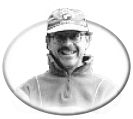
Trolling For Salmon
Part 2
with
D.C. Reid
Almost synonymous with the word trolling is the word Down rigger. All saltwater trollers are familiar with their use. For the uninitiated, however, a Down rigger is plastic gurdy of wire line on the end of which is a ten pound lead ball. The fisher attaches a fishing line to the Down rigger line by means of a release clip and lowers the lead ball to fishing depth. When the salmon bites, the fishing line releases from the Down rigger and the fight - without any weight between fish and fisher - is on.
The use of down riggers has revolutionized salmon trolling. Prior to their introduction, heavy rods with their 6" wooden recorder reels and heavy weights were needed to get lures to fishy depths. Down riggers have changed that. Now, light limber fibreglass rods in the 7 ½- to 8 ½-foot range may be utilized; the considerable drag exerted by water is taken by the Down rigger ball.
One small tip may make using a Down rigger less expensive. From time to time, even the best fisher hangs up on something that rips off a Down rigger ball. The endclip separates and prevents the Down rigger itself being ripped off the boat or, worse, the boat being tipped on its end and disappearing beneath the waves. To help prevent these possibilities, but still allow the ball to rip off when it ought to, tie a one foot loop of Dacron between the lead ball and the endclip.
Before moving on to trolling reels, one last subject should be raised. In recent years more and more research has given strong proof that fish are particularly sensitive to changes in
electrical potential
in the water. Indeed, different species of salmon prefer juicier currents: .60 volts for chinook; .65 for coho; and, .75 for sockeye. These charges can be imparted to your gear with a device known as a Black Box. Many saltwater guides have reported that when gear is properly tuned, schools of salmon will be seen forming on fish sounders and then following the gear. What could be better?
Fortunately, there is a cheap way to influence the electrical potential around your trolling gear. Haul out the good old green Dacron again and tie a 1 ½- to 2-foot length between the Down rigger line and the endclip, thus isolating the largest chunk of metal - the lead ball - from the line. In addition, a 2 inch brass clip is added; to the top end of the Dacron when fishing for sockeye, to the bottom when fishing for other species.
Now onto reels. Three types of reels find common use in trolling. As mentioned, the now old fashioned but superbly made, wooden recorder reels should make it into every true afficionado’s tackle box. They are the workhorses of the market and virtually indestructible. Over the years, though, they have been replaced by sportier single-action graphite reels. Bigger cousins to freshwater fly fishing reels, these reels, as the name implies, allow line to go either in or out. True fishing pleasure results from the fight being controlled by one’s palm providing drag against the reel. A third reel-type currently gains in popularity, the star-drag, level-wind troller often made of beautifully-balanced corrosion-resistant metal alloys. It’s chief advantage lies in that it allows the fisher to reel in while the fish pulls out, less sport perhaps but manageable by every novice on the water.
Once the rods are in the water, the most important objective arrives: finding the fish. I fish in Juan de Fuca Strait, the 25 mile wide, 1000 feet deep body of water separating
Vancouver Island
and Washington State. It’s pretty obvious that only an extremely small portion of the water contains all the fish. Success most often results from the fisher knowing the species of salmon for which he or she fishes; each
species
has different behavior. Sockeye, pink and chum are migratory salmon encountered only in the summer months of June to September. Freely migrating in schools, these fish may usually be found in the first 60 feet of water anywhere from right on shore to 12 miles out. Coho, on the other hand, will virtually always be found associated with tide lands - those dark surface lines where two opposing currents meet - in the top 50 feet of water 1 to 4 miles offshore.
Chinook buck the trend. Winter or summer they reside in an area or mosey through it in definite relation to land structures, whether under water, as in reefs or banks, or above water points of land. Search out the back eddies and there they shall be found. In winter, resident chinook numbers dominate in the 100 - 140 foot layer of water. In summer, they may ascend or descend the water column great distances. Found at the surface (0 to 25 feet) and closer to shore at the crack of dawn, chinook may descend as much as 250 feet during daylight hours. In my estimation, nearly all the available chinook may be found in about 1% of the available ocean, hence the importance of locating the fishy fraction becomes clear.
Not to be overlooked is advice from the local marina. Good local marinas will know up to date information on precise fish location, depth, tide and current considerations and the hot lures from recent days. Pay attention. Among other things, make sure you know whether a dodger or flasher is used, along with its brand name, - fish are that specific - the brand of baithead locally employed and the length of leader. In recent years, correct leader length has often spelled the difference between success and skunk. Bait leaders, for instance, have lengthened from the 30 to 36 inch range for chinook to 5 to 7 feet. Accordingly, accurate local info is a must.
Read
Trolling Part Three
:
Hot Lures and How To Rig Them.
|



